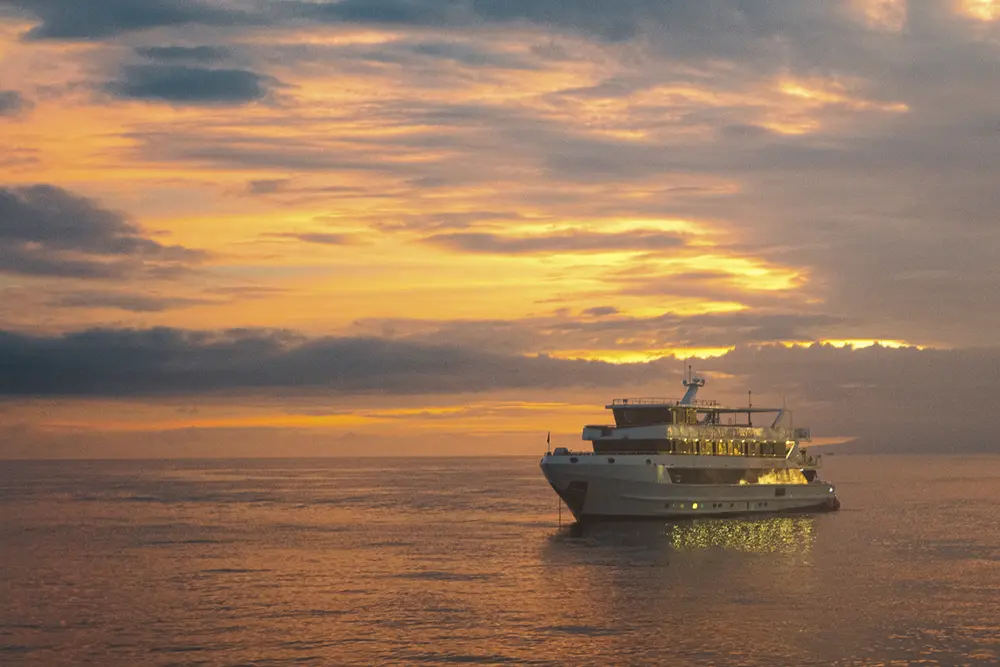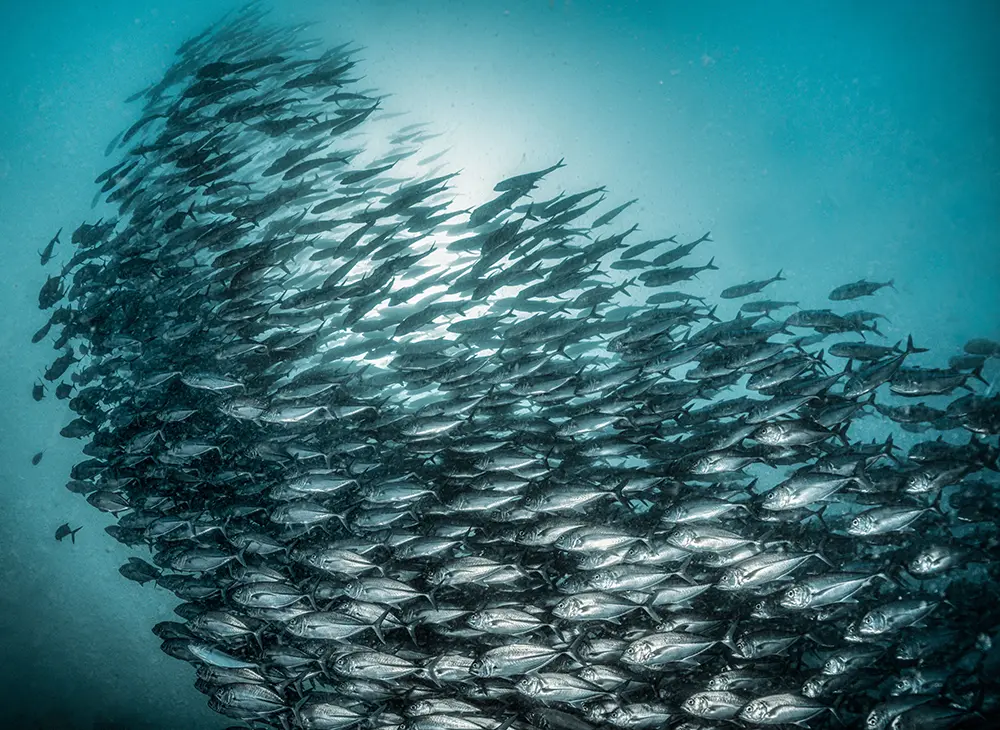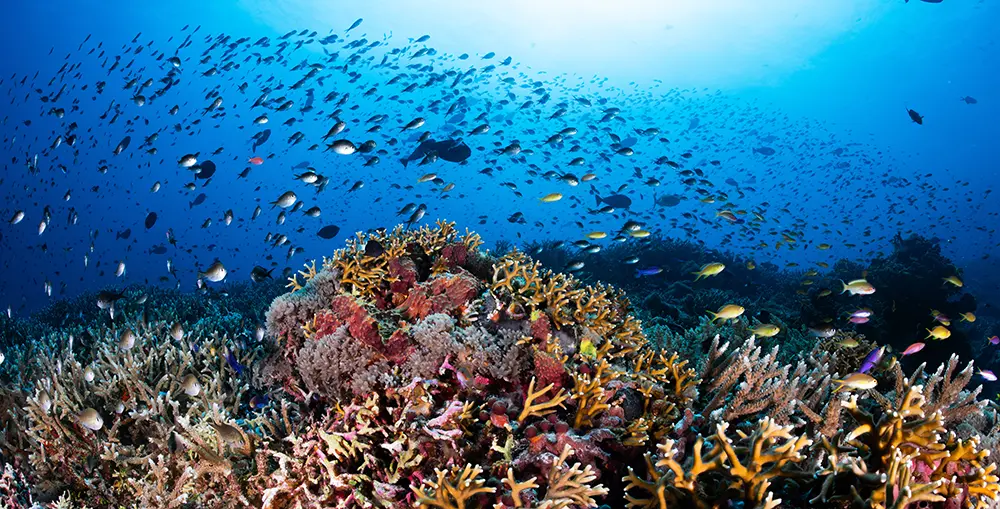
Every year, Aggressor Adventures’ Philippines Aggressor makes a transition voyage between Cebu in the Visayas to Tubbataha National Park. Mark B Hatter and his camera hopped on board to enjoy diving the Philippines’ immensely diverse reefs.
Words and photos by Mark B Hatter
It’s taken 36 hours of continuous flying to reach Cebu, on the opposite side of the globe and 180 degrees out from my regular circadian rhythm. I should be fatigued to the bone, but I’m too amped up to sleep because tomorrow, my dive buddy Kevin and I will board the Philippines Aggressor liveaboard for its annual 10-day transition cruise from Cebu to Tubbataha.
We board the beautifully appointed and spacious vessel the following afternoon, make crew and guest introductions, complete requisite boat briefings and assemble our dive gear and camera kits at our appointed stations on the dive deck.
In the evening I enjoy a cold beer and a pastel sunset highlighting the Mactan–Mandaue Bridge and Cebu’s metropolitan skyline from the liveaboard’s upper deck, and start thinking through the photo-opportunities this trip – the Tubbataha/Visayas Transition itinerary – might present, from whale sharks to nudibranchs and sweetlips to anemonefish, should our fortune be good.
I finish my beer and my thoughts just as the Philippines Aggressor’s engines rumble to life. Suddenly, the fatigue of flip-flopped time zones finally hits me, and I head to my cabin to sleep.
More from Aggressor Adventures
- Aggressor Adventures launches three new liveaboards
- DIVE’s Big Shot Portraits – THE WINNERS!
- Anne Hasson announces retirement from Aggressor Adventures
- Aggressor Adventures’ BVI Aggressor liveaboard highlights

The Visayas
The Visayas are the islands that form the central part of the Philippines archipelago, situated between Luzon to the north and Mindanao to the south.
There are seven large and several hundred smaller islands subdivided into four regions – the Western Visayas, Negros Island Region, Eastern Visayas and the Central Visayas in which Cebu and Bohol are located.

The geophysical presentation of the Visayas is a defining feature of the islands’ underwater topography and how it translates to dive site diversity.
The Pacific Ocean pushes and pulls huge volumes of water through deep trenches between adjacent islands, creating a Venturi effect which generates swift currents and nutrient-rich upwellings.
These features give the Visayas some of the most prolific biodiversity and dive site variability within the Coral Triangle, from precipitous walls and dense stony coral forests to verdant grass flats and black sand muck sites sheltered from the currents in island lees, meaning each dive on board the Philippines Aggressor offers something different and unique.

Our first dive the next day is at Cabilao Island for an early morning dive at Lighthouse. The sun is barely over the horizon as we roll into the 26°C water and ride the strong current down its steep wall to a tapestry of lengthy wire corals and elephant ear sponges projecting from the wall’s vertical face.
After 50 minutes, the current slackens just enough that I can shoot dozens of golden-colored Anthias, nose to the current, against a city of similarly coloured fire corals lining the rocky reef’s crown, until it’s time to swim to the channel for our safety stop.
After a hearty breakfast, we dive a site off the small island of Pangalo named Gorgonian Wall. The waterscape is dominated by red and pink carnation coral and more oddly-shaped sponges, rather than the gorgonians we anticipated based on the site’s name.

One of the advantages of the Philippines’ Coral Triangle biodiversity is its potential for discovery; like Forrest Gump once said about his box of chocolates: ‘you never know what you’re going to get’!
So it was with Gorgonian Wall when I happened upon a pair of copperband butterflyfish – only my third encounter with these spectacular creatures in decades of Indo-Pacific diving.
The variety of diving and parade of biodiversity continued the next day at Napaling Point, on the south side of Bohol. The site seemed to combine all of the previous day’s attributes while adding even more: vertical walls carved with overhangs and crevices, dramatically framed by giant sea fans.

The crown of the reef at the top of the wall was no less dramatic; as we moved toward our safety stop, the thickets of staghorn corals, accentuated with shoals of colourful fish, were stunning!
One of the coolest dives in the Visayas is Oslob off the south end of Cebu. Here, the local economy shifted many years ago from fishing for sustenance to feeding fish for tourism.
Whale sharks are abundant in the Visayas’ waters, and at Oslob, they have been conditioned by fishermen to feed every morning on krill ladled into the water for snorkelling tourists.

Scuba diving with the sharks is also permitted, and so the Philippines Aggressor makes this one of the signature dives on its Visayas circuit – a great opportunity for divers while at the same time contributing to the local economy.
The whirlwind tour of dive sites continues over the next two days, each of them akin to another act in a three-ring circus. At Dakit Dakit off Pamilacan Island, we sailed with the current past schools of horse-eye jackfish and giant magnificent anemones anchored on red, yellow and orange coloured bommies.

At Spanish Tower, we encountered a bubble-blowing turtle, and at Kalipayan Wall, we switched to shooting macro to capture nudibranchs, moray eels and tiny bubble coral shrimp.
By the end of the fourth day we’d taken in the National Marine Parks at Sumilon Island and Apo Island while squeezing in two muck dives off the south end of Negros Island.
Our luck was good and our ‘chocolate box’ of discoveries just kept piling up; from ghost pipefish and tiger shrimp at Thalata House Reef to giant lettuce corals, sea snakes and an underwater vista displaying every colour of the rainbow at Apo Island’s Coconut Point.

On the evening of the fourth day, the Philippines Aggressor begins the two-day transition to Tubbataha with a stopover at the halfway point, Cagayancillo Island, for a day’s diving at Subway and Landing Strip.
The visibility at both sites is outstanding and the vertical walls here provide yet another different set of examples of the Philippines’ biodiversity.
Giant sea fans and scores of angelfish typified our Subway experience while red, pink and yellow wire gorgonians surrounded by shoals of pyramid butterflyfish showcased Landing Strip.
Tubbataha
At 38 metres in length with an 8.5-metre beam, the steel-hulled Philippines Aggressor made smooth sailing of the passage from Cagayancillo to Tubbataha, a UNESCO World Heritage Site consisting of three atolls situated 8.5 degrees north of the equator in the middle of the Sulu Sea.

The three atolls – North Atoll, South Atoll and Jessie Beazley Reef – are classic atolls, with reef formations beginning near the surface and sloping to around 20 metres before dropping vertically to deeper than 300 metres.
The reef tops are covered in thickets of stony and leather coral, and the perpendicular walls at each atoll’s signature dive sites feature some spectacular overhangs, ledges and caverns.
The wind had picked up by the time we were prepping for our first dive on North Atoll at the Malayan Wreck, but with buoy-marked sites encircling the atoll, it’s always possible to dive in its lee, away from any wind or swell coming from the opposite direction.
The Malayan Wreck is a fishing vessel which smashed onto the northwest side of North Atoll during a typhoon in the 1970s. We rolled into the water just after sunrise to be greeted with spectacular visibility of more than 30m and surgeonfish, butterflyfish and angelfish milling around the wreck and a school of large sweetlips claiming the wreck’s interior.

The currents at Tubbataha are legendary and as fickle as the monsoon’s transition. They can change speed and direction rapidly depending on the tide and the dive site’s topography.
Divers are easily separated by the current, and as photographers, Kevin and I found ourselves separated from the group after loitering for a shot, but competent dive buddies with SMBs are given wide latitude by the Philippines Aggressors’ crew.
Indeed, we found ourselves leaving the walls early on dives to exploit the best wide-angle opportunities on Tubattaha’s reef tops, where good fortune materialised first in the form of a school of spawning orange-shouldered surgeonfish, then in a diver-friendly school of pod of bumphead parrotfish after we reached the reef top.
I am particularly partial to shooting panoramic coral vistas, and Tubbataha did not disappoint. At every dive site, the reef top leather and stony coral forests were vibrant, healthy and loaded with colourful fishes from moorish idols, bannerfish and pairs of butterflyfish to dense clouds of Chromis damselfish and several species of anthias.


While my favourite reef-top dives were at Black Rock, Ranger Station and Delsan Wreck, Kevin and I did not disregard the wall diving altogether, which presented us with wonderful photographic opportunities.
We descended the reef at the aptly-named Wall Street and delighted at the multicoloured crinoids perched on sponges and wire corals, while midway through the dive, a shoal of swirling bannerfish added a perfect counterpoint to the anchored wall animals.
Wall Street’s wall, however, was eclipsed by the compound vertical surfaces at Jessie Beazley reef, sliced with gaping crevices, massive overhangs and huge ledges that provide a latticework of surfaces for massive sea fans, pastel-colored carnation corals, three-metre-long wire corals and enormous barrel sponges that were, literally, too big to photograph. It is mind-blowing!


Eventually, the journey must reach its conclusion, and at the end of the ninth day, we rode a monsoon-driven following sea back to Puerto Princesa on the island of Palawan where my good fortune conitnued – thanks to my flight being delayed I was able to fit in two dive at muck sites just outside of Puerto Princesa before the Philippines Aggressor docked.
The muck dives off Palawan gave me a therapeutic come-down from eight days of sugar-high imagery captured at arguably the best diving sites the Philippines has to offer. Indeed, the journey from the Visayas to Tubbataha on the Philippines Aggressor is an adventure for everyone’s bucket list.
But don’t take it from me, check out the images and then decide!
Philippines Aggressor: need to know

The Philippines Aggressor (and the Philippines Aggressor II) offer 10-day charters encompassing the Visayas and Tubbataha twice a season in March and June.
Between the transition trips, each yacht runs weekly cruises in either the Visayas or Tubbataha, depending on the season. The crew is friendly, incredibly experienced and gives each guest the best Philippines experience they can muster.
Aggressor Adventures maintains a high standard for liveaboard performance, and the Philippines Aggressor exceeds that standard on every level, from spacious cabins with private bathrooms to scrumptious local and western cuisine. The company mantra is Dive, Eat, Sleep, Repeat, and the crew of the Philippines Aggressor knows how to execute this mantra well!


